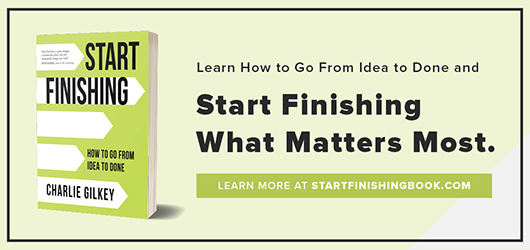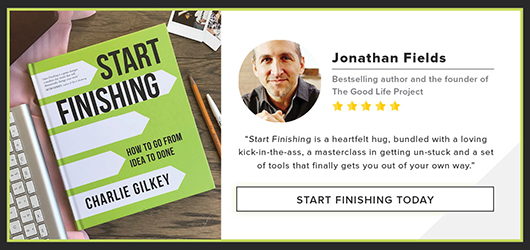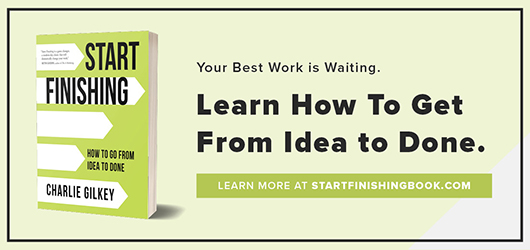Reviewer Melissa Wuske Interviews Charlie Gilkey, Author of Start Finishing: How to Go from Idea to Done
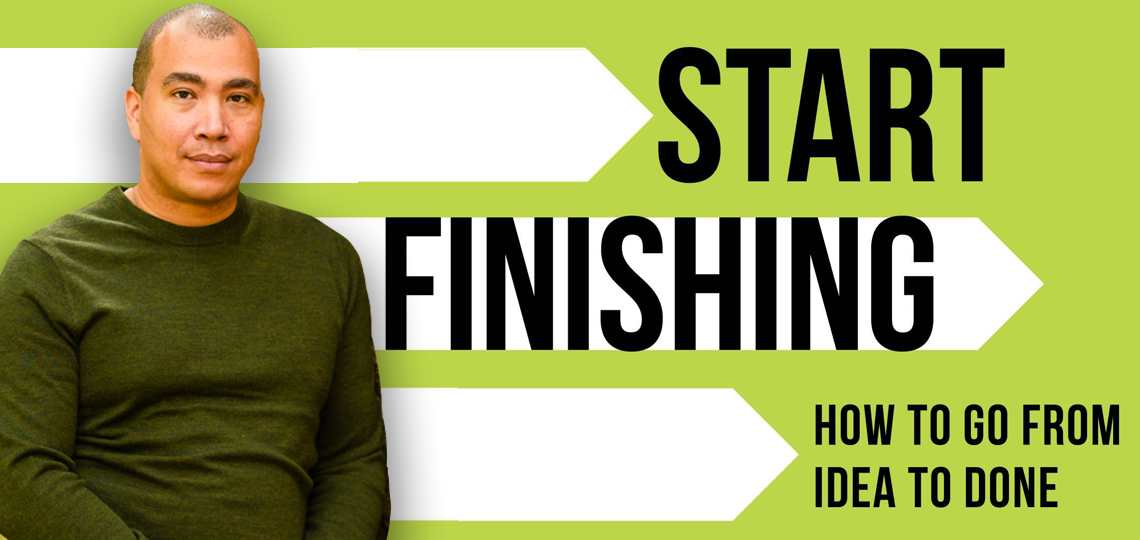
Just as the COVID-19 virus seems to find its victims arbitrarily, all of us in the work-from-home brigade have adapted differently to the new working conditions. Some people love the freedom and isolation, others are coping okay but look forward to getting back in the office with coworkers, and a few are struggling mightily—the stress, seclusion, and shifting routines have been soul sapping.
If you happen to be in the just-making-do or worse categories, Charlie Gilkey would like you to cut yourself a break. The author of Start Finishing: How to Go from Idea to Done, Charlie’s passion is helping others improve their productivity, so he knows better than most that the present circumstances are unprecedented and we all need to be honest with ourselves about the difficulty. Remember, you didn’t ask for this. You’re doing the best you can.
In the months following the book’s release, Start Finishing was named a Top 10 Business and Economics Book by Publisher’s Weekly, Kirkus Reviews Top Indie Book, Montaigne Medal Finalist, Independent Publisher Book Award 2020: Silver Award, Eric Hoffer Book Award 2020: Grand Prize, and a Foreword Indies Finalist.
Melissa Wuske reviewed Start Finishing in a recent issue of Foreword Reviews. When we reached out to her about firing a few productivity and goal setting questions at Charlie, she jumped at the chance.
Melissa, take it from here.
The recent quarantines for COVID-19 have led many to think about productivity—its true value and how to achieve it. What lessons can you share about what works and what doesn’t?
While COVID-19 has been incredibly challenging, like any crisis, it’s also borne many gifts. One of those many gifts is that we’re asking a host of better questions, with “what’s the true value of productivity?” being one of them. On that note, I’ve never seen productivity merely about getting more things done or merely being better at work—in its broadest sense, productivity is about doing the activities that lead to holistic thriving. What it means for an organization to thrive is different from what it means for an individual person to thrive, though an organization can’t thrive (for long) if the individuals that make it up aren’t thriving as well.
What COVID-19 has surfaced is how much of our thriving has been founded on (previously) underappreciated interdependencies, structures, and environments. Many people took for granted that food would be available, toilet paper would be stocked, and that there was a default place, time, and way work happened. Many people have realized that the commute they hated before COVID-19 actually provided them a buffer between home and work that let them prepare for each. Parents have realized in a completely different way how much their work and happiness rely on teachers, coaches, and a web of other adults to nurture, teach, and attend to their children.
When those interdependencies, structures, and environments changed overnight, the ways we work as individuals and organizations either no longer worked or didn’t work as well. In reaction, many people and organizations shifted into survival mode. Survival mode has different goalposts than thriving mode, but, unfortunately, many people and leadership teams continue to try to operate in survival mode but expect themselves and their team to have outcomes as if they were in their normal thriving, abundant mindset. Generally speaking, the amount of available focused time, energy, and attention we have is much lower than it was before COVID-19.
What does and doesn’t work during this period are flip sides of the same coin, so I’ll give three related best practices:
-
Instead of expecting pre-COVID-19 levels of focused time, energy, and attention, use actual focused time, energy, and attention as a gauge for goal-setting, prioritization, and planning. COVID-19 has created new projects for us that we have to attend to and these new projects are displacing pre-existing ones and using the available time, energy, and attention we might have had for new ones.
-
Instead of expecting pre-COVID-19 goals and priorities to be relevant and operative now, reevaluate what truly matters and prioritize your efforts around that. Work harder to cut the unimportant stuff and use that recovered capacity for the important stuff.
-
Instead of expecting your pre-COVID-19 ways of working to work, reevaluate, renegotiate, and rebuild your workways. While you’re doing this, be patient and compassionate with yourself and your coworkers; we’ve been in our entrenched workways for years or decades and it’s reasonable to expect that it could take us years to adjust to this new world we live in.
Relatedly, as more and more people are working from home, what are some productivity tips, going beyond the basics? How is work from home a detriment to meaningful work, and how is it ideally suited to pursuing a dream?
The key thing we have to keep in mind is that what we’re doing now is much more than merely working from home; a better way to think about this is that we’re working while under quarantine. I share this because many people who once fantasized about working from home have turned sour on it since March 2020, but this way of working from home is dramatically different, even for those for us who have worked from home for decades. If nothing else, having kids underfoot all day and learning how to homeschool or partner-teach them while you’re ostensibly “at work” ratchets up the difficulty of working from home exponentially.
Here are some tips for working from home:
-
As much as you can, have a dedicated place to work that blocks as many visual and auditory distractions as possible. It’s incredibly difficult to focus on your work when you can see the laundry that needs to be done or hear your kids fighting over a device. Noise-canceling headphones can be expensive but they pay for themselves very quickly—think of the investment in them as a substitute for what you used to pay for a commute.
-
Take a lunch break of at least 30-minutes away from “work.” Leave your work devices in your work area so you can actually take a mental break. Even better if you can take a walk and get some movement in. Aside from the mental break, this helps break the day into more coherent blocks.
-
Have a consistent checkout time and use a combination of commitment devices and transition activities to help you keep it. If your pre-COVID hours were 8–5, stick to checking out at 5 and enlist your family or friends to help you stick with it. Going for a post-work walk, starting dinner, or calling a friend can be great transition activities.
While I could write another whole book on tips for working from home, I’m including the three above because we’re starting to see a lot of burnout and fatigue from people who are new to working from home. The trick to sustainably and effectively work from home is to master boundaries, transitions, and energy management. Without the commutes, lunches, and explicit work hours, many people are having trouble structuring their workdays and spending more hours looking at screens, but not really getting their most impactful work done.
While working under quarantine has benefited people who have fewer distractions at home and want to do solo projects, it’s significantly impacted a lot of people whose most meaningful work is done in collaboration with other people. It’s not just that we can’t meet with others, but that many people are either focused, distracted, or overloaded with everything going on. Though we can meet virtually, many people are tapped out on virtual meetings or just not in the space for the type of soundboarding, strategizing, and collaboration that powers our best work. The most significant detriment for many is feeling isolated or not feeling the positive buzz from others that many of us now realize is such an essential part of doing our work.
That said, working while under quarantine is ideally suited to pursuing a dream if people establish good boundaries and select right-sized projects that need focused individual work. It can be a great time to move the itch to start a business to an actual plan, or to finally start working on the book that many people have been putting off or thinking about for years. It can also be a great time to dust off the guitar or start training for a marathon. The more we shift into what we can do, or, even better, the unique opportunities that this period of time sets up for us, the more we see that now’s a great time to push dreams forward rather than merely putting them on hold.
I want to be careful here, though, because many people are beating themselves up for not doing all the things they could right now. It goes back to what I said above about people expecting their focus and output to be the same as during normal periods, when in reality, COVID-19 has created a few projects on its own that we can’t opt-out of. Rather than shoulding all over themselves, I’d much rather people get real about how much discretionary focused time, energy, and attention they actually have and use that to determine what to commit to instead of getting into a shame spiral about all the things they could be doing right now that they’re not getting to.
The book discusses accounting for drag points that slow down the pursuit of a goal, particularly related to myths people have about success, much of which are related to foreseeable factors in the personal realm. In the present moment, many are facing circumstances that feel unforeseen and more universal than personal. Are there any new or recurring myths that are particularly waylaying people during this time?
The three myths of success that I present in the book are still operative, but they’re working in a much different way during this time. At the same time, many people’s head trash is much louder, too, because they are not around their yaysayers enough to override their own insecurities and self-limiting beliefs.
For instance, the general “Success Versus Virtue Myth” that undergirds statements like “nice guys finish last” or “real artists can’t have commercial success” now looks like “people who are doing well right now aren’t empathetic or in touch with what’s going on.” I’ve talked to so many people who are thriving right now but actually feel ashamed about it, in part because of this version of the myth being so powerful but also because they’ve been passive-aggressively shamed for it. This gets fused with the “Success Will Wreck My Relationships” tale such that people stop doing the work that’s leading to their thriving because they don’t want to be out of touch with the people they care about, and/or are internally ashamed about doing well. Similarly, the “What If I Can’t Do It Again” trap now looks like “what if I do something and the only reason I’m successful with it is because of unique conditions presented by this period, but when they go away I won’t be as successful?”
That these myths are so adaptable is what gives them their power. It’s unfortunate that so many of us have an anchored belief that we’re uniquely defective and/or not good enough, and are always imagining or creating scenarios that show that rather than starting from the mindset that we’re already more than enough and will be able to adapt and overcome to whatever comes our way. More than any technique, tip, or practice one might glean from Start Finishing, I most hope to shift people’s default mindset from “I can’t because …” to “I can because …”.
The concept in the book of thrashing is particularly intriguing: “emotional flailing and metawork we do when we don’t fully commit to our best work.” How can people recognize this in themselves, embrace its significance, and move forward?
I’ve found that most people actually already know how they thrash. It could be “research” that lets them put off making the decision. It could be the laundry that absolutely has to be done before they can start working. It could be checking Facebook or Instagram when they’re feeling insecure (like that ever helps). What makes thrashing so frustrating is not that we don’t know we’re doing it, but rather we know (at some level) that we’re doing it and still keep doing it anyway.
The thing about thrashing is that we only do it when something matters to us—the more it matters, the more we’ll thrash. Few people thrash about doing the dishes or taking the trash out; sure, we may not want to do it and may put it off, but it’s not a mini-existential crisis or a stake in the ground about our identity. Starting a business or nonprofit, getting married (or divorced), looking for a better job, moving to a new region—those kinds of choices matter to us.
To make matters even worse, many people have a belief that if something is hard, difficult, or uncomfortable, maybe it’s not something they should be doing. It’s an implication of the talent myth: some people have a talent or knack for doing something and, for them, it comes easy—if it’s not easy for you, then maybe you should go find what your talent is. Most people don’t find that easy thing so they feel like they don’t have any talents. In reality, talent emerges after people have put in the work. We don’t start by being good at something from the beginning; we get good at something by working through being bad at it in the beginning.
Understanding that thrashing is a sign that something matters, it’s a natural part of the process, and that emotional tension isn’t a sign that maybe you should find something else helps many people head toward the thing that’s making them thrash and stick with it until they make it through. I’m not advocating making life and work harder than they need to be but knowing that your best work is likely going to be hard (in parts) helps you do more of it. And the more of your best work you do, the more you thrive.
Momentum is a key idea in the process you describe. Talk about how it shifts and changes through each part of a project, and why it’s so vitally important.
While Start Finishing isn’t merely a project management book, the through line of the book is that projects are the bridge between our current world and the world we want to live in. We don’t do ideas—we do projects. Many people aren’t getting any momentum on the stuff that matters to them because they haven’t converted their ideas into projects.
To keep things simple, let’s break any given project into the three logical parts of beginning, middle, and end. Getting through our projects would be a far easier task if we all struggled in the same parts of the project in the same way. Alas, some of us are quickstarts and love the beginning of the project and then peter out, just as some of us love the excitement of being near the end of the project and get energized to push it through. Regardless of our different affinities for parts of a project, there are common patterns that happen in each stage.
To keep momentum going in the beginning of the project, the main task is to figure out how to direct the motive energy of the idea and create some containers that keep it going. Deciding what level of success you’re going after, putting a start date on the project, and building your success pack (before you build the plan) are all ways to make sure you don’t fizzle out before you start.
The middle of the project gets challenging because that’s when you and the project are pushing against reality. To maintain momentum here, you have to spend time working on the project, which means you need to get it on your schedule and you have to use enough of your scheduled time working on it. Yes, this is obvious, but many people are struggling with their projects simply because they’re not spending enough of the right kinds of time working on the it. If the first part of the project is about battling with your insecurities, the middle part is about battling with your priorities.
By the time you start reaching the end of the project, there’s a lot of momentum to the project at the same time that there’s some heavy walls at the end. I call the end of the project the red zone, which is a reference to the tendency of teams in American football to reach the last twenty yards and fail to get a touchdown. Getting through the red zone is often challenging because the insecurities you thought got put to bed come out again in full force; perfectionism, imposter syndrome, scope and goal creep, and fears of success join forces right when our energy with the project may be flagging. Whereas getting through the middle of a project requires navigating a messy, wide-open field, getting through the end of a project requires focused attention in tight spaces where details truly do matter.
Too many people get stuck in the different parts of a project because they’re trying to make reality look like their plan or are frustrated when their plans don’t match reality. Reality has an annoying habit of not looking anything like our plans. Rather than get hung up on that, I want people’s guiding question throughout the project to be “how do I keep momentum going with this project?” rather than “how do I stick with the plan?” Momentum keeps you in the project until you’re done; a good plan has enough information to keep momentum going without the plan itself being in the way or yet another thing to do or thrash about.
In today’s world—a pandemic, racial violence, political turmoil—most people seem incredibly worn out or intensely eager to do something big, new, or meaningful. Can you speak a message of hope for each group?
For those who are incredibly worn out, please give yourself the grace and compassion to stop comparing what you’re able to think, feel, and do now with the BeforeTimes. Our world has changed and it’s clear that it won’t be going back to the way it was; at the same time, we’ll co-create a better new normal as we go along. Co-creating that new normal amounts to a lot of projects, which is part of the reason why you’re worn out. Staying healthy, staying sane, and getting enough done to get by are the priorities and success conditions—anything else is gravy.
If you’re intensely eager to do something big, new, or meaningful, please give yourself permission to get after it. Do not be ashamed for shining and standing tall; dark times need even more lighthouses. How fast you’re able to go and what you’re able to build is not nearly as important as the fact that you’re going and building. Lastly, you’re not alone and create the success pack that will help you through this.
Start Finishing
How to Go from Idea to Done
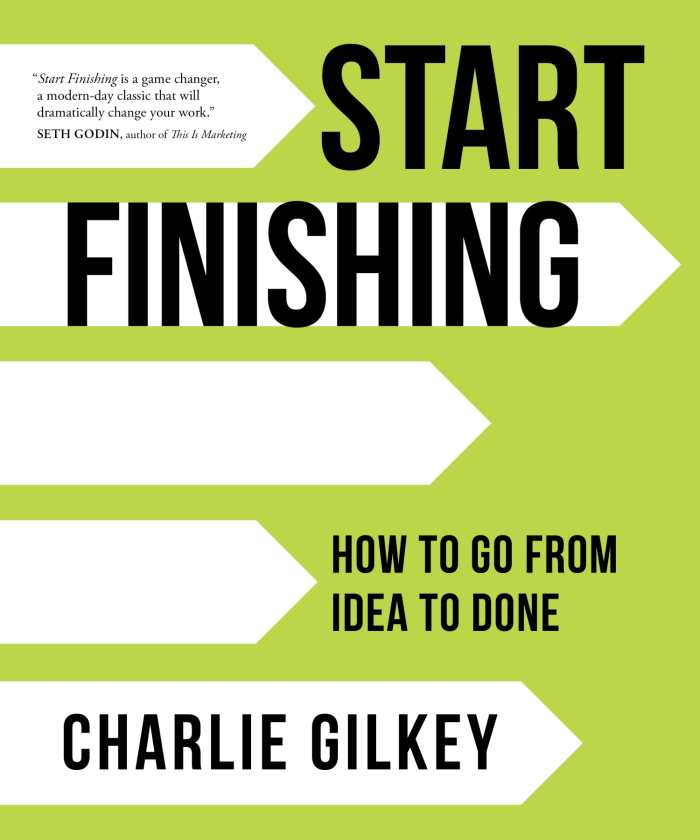
Charlie Gilkey
Sounds True
Hardcover $24.95 (224pp)
978-1-68364-263-3
Buy: Local Bookstore (Bookshop), Amazon
Charlie Gilkey’s Start Finishing addresses productivity problems and provides transformative solutions.
Most people are busy all day long, yet nothing ever seems to get done and no one seems fulfilled. In Start Finishing, productivity isn’t about getting a new planner or organizational system; instead, how people think about what they do has everything to do with fulfilling their goals.
This practical book shows how to map out projects from start to completion, preserving the intent of the work and keeping it from getting derailed. The map begins by listing the “chunks” of projects, sorting them into categories, and putting them into sequence, until everything is on a manageable schedule.
Step-by-step advice prevents the disconnect that occurs between big picture visions and the small tasks it takes to complete them. The book’s introspection will help with identifying and disarming negative self-talk, and inspirational anecdotes suggest that change is possible. Sidebars from Seth Godin, Joshua Becker, Susan Piver, and other creative and strategic thinkers are insightful.
Clear and positive tones make it easy to follow along and learn how to act upon the book’s ideas right away for fast results. The book has lots of energy and eschews hype, extremism, and prescriptive thinking in favor of strategies that are realistic, sustainable, and adaptable.
The book’s approach to productivity is relevant to any kind of project—across professional fields, hobbies, and personal development—but the book has an entrepreneurial business sensibility that will draw in creative problem solvers and mission-oriented professionals.
“Good work” isn’t about completing a task; it’s about fulfilling a dream, making the world better, and becoming who we want to be. Start Finishing lives up to its promise to help people get good work done.
MELISSA WUSKE (August 27, 2019)
Melissa Wuske

